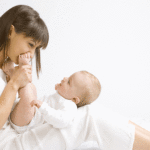
First Bathing of Your Baby
The first bathing of your baby is a true milestone. However, each parent asks how and where to give the baby a bath as well as when to give a bath. Cleaning a slippery baby wriggling and sometimes screaming requires experience. For this reason, keep calm; it will get easier gradually and your baby will begin to love water splashes by time.
How Often You Should Give Your Baby a Bath?
As long as you keep the diaper area of the newborn well-cleaned and wash his hands and face many times, it will probably be sufficient to give him a bat twice or three times a week. The newborns cannot dirty their clothes unless they vomit or wet themselves.
This bathing period may be virtually every day for older babies since the bath time usually becomes a part of sleeping time schedules. This may be a perfect way of helping your baby relax at night.
Giving You Newborn Baby Sponge Bath
It is the best option to give a soap bath to your baby before his umbilical cord detaches (10 days to three weeks after the birth) in order to prevent the umbilical cord to get wet. The method is as follows:
Put your baby on a soft and flat surface (a clean towel will answer the purpose). Keep a basin of hot water and a sponge or hand towel ready for use.
Keep your baby swaddled warmly, keep only one arm/leg uncovered and wash it gently.
Dry the area gently and begin to clean the other arm/leg.
If the umbilical cord gets wet accidentally use only a towel to dry it gently.
True Bathing
Your baby gets ready for a true bath in a washbowl or baby basin after the umbilical cord detaches. Whichever you prefer, lay towel under him to make it softer. Furthermore your spouse’s assistance to hold your slippery little one may be useful. Prepare everything you will need beforehand so that you will not have to look for it during the bath.
A sample list is as follows:
- A big towel with a hood
- A soft hand towel or sponge
- Cotton balls
- Baby soap or liquid bath soap
- Baby comb or brush
- You will need warm water with depth of only 5 cm in order your baby’s bath to be effective. Try covering the navel with a warm hand towel in order to prevent your baby to catch cold.
The first baths needn’t be long or detailed; but they should be effective. Hold your baby tightly and gently and remove all remnants or skin residues washing. You will need to support his head and back like a cradle. Particularly pay attention to the following while washing:
- Sexual organ and baby diaper areas.
- Hands and feet. Check finger webs and toe webs as well.
- Skin layers under the knees, neck and groins.
- Face. If there are remnants around the eyes, use cotton balls to remove them.
- Armpits – naps of infant bodysuits could pile up there.
- Ear backs.
Hair And Cradle Care Of The Newborn
Not all babies are so lucky that they have full hair; however, if your baby is lucky wash his hair with a soft baby shampoo as required. Apply a small quantity of shampoo on his hair, massage gently and let it absorb, keep waiting for a short time and then remove it rinsing. Wash your baby’s hair most recently so that he does not have to sit in soapy water.
Water Temperature Of Baby Bath
Your baby’s skin is more sensitive than yours. As a result, the bath water which is good for you could be too hot for him. Check the water temperature with your inner wrist or elbow before you approach your baby to the water: those areas are more sensitive to heat than your head. You should feel the water to be warm but not hot!
Finally, do not be astonished if your baby cries during the first few bathes. He only reacts to an unknown experience. Keep the room warm and the bath water at a relaxing temperature and clam him down caressing him and singing for him. He will soon learn enjoying the bath time.


